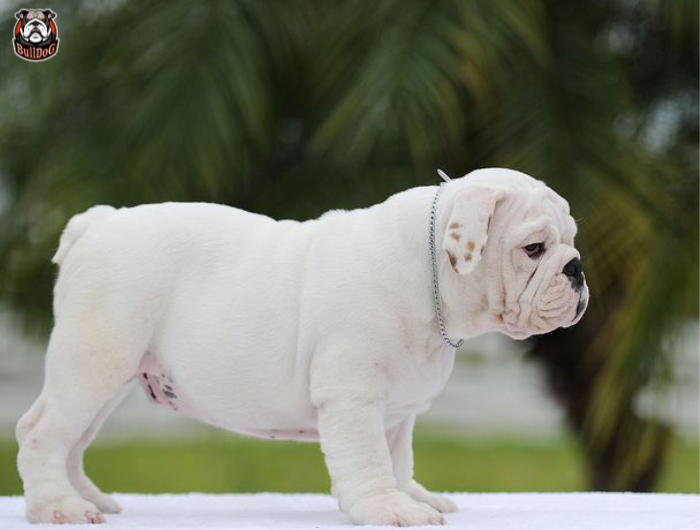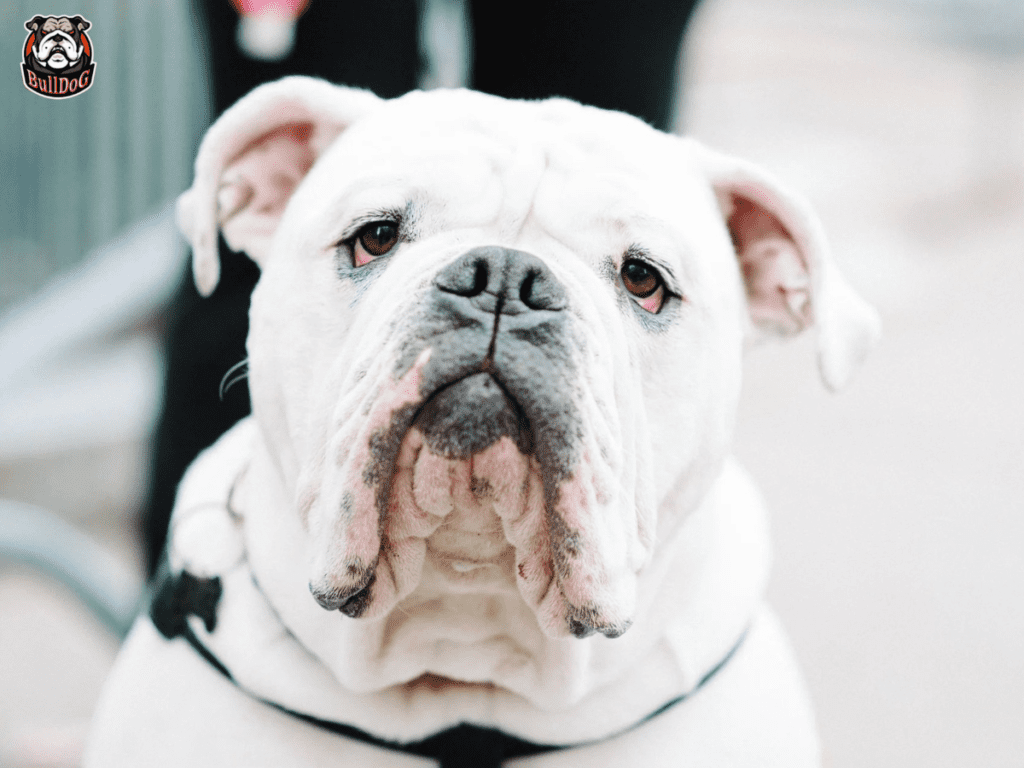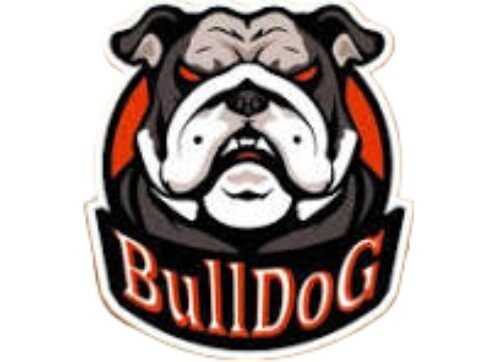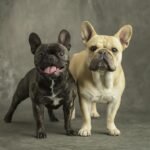Bulldogs, often misunderstood in terms of their intelligence and character, defy stereotypes with their unique blend of traits. While some may perceive them as lazy couch potatoes, Bulldogs exhibit qualities such as faithfulness, stubbornness, protectiveness, and unwavering devotion to their loved ones. Despite individual differences, these traits shine through, challenging misconceptions and showcasing the true essence of the Bulldog personality.

The Evolution of the White Bulldog Coat
Origins: The White Bulldog coat has deep roots in Bulldog history, initially recognized as one of the original coat colors alongside red. Back in the early 1800s, Bulldogs were mainly used for tough jobs like bull baiting and bear hunting across Europe. They were bred to be low to the ground and fierce in demeanor.
Changing Times: As bull baiting and bear hunting practices were outlawed, the need for such aggressive dogs declined. Bulldog enthusiasts attracted to the breed’s loyalty and toughness, shifted focus toward creating companion dogs. Breed standards were revised to reduce aggressiveness.
Preference for Calmness: White and red-coated Bulldogs were favored for their perceived calmer demeanor, leading them to become traditional colors in breed standards. These colors were seen as a means to control the original Bulldog’s aggressiveness.
Acceptance of Fawn Coat: Initially viewed as more aggressive, the fawn coat color eventually gained acceptance as the third traditional color in the English Bulldog breed standard, reflecting the evolution of attitudes toward Bulldog temperament.

Physical Appearance:
English Bulldogs have a unique look, easily recognizable in pictures. They feature small, thin ears positioned at the back of the head and deep folds of loose skin starting from the forehead down to the jowl. Their anatomy is brachycephalic, with wide-set eyes above a short muzzle, broad black nose, hanging upper lips, and a strongly undershot lower jaw.
Body Structure:
Known for their large heads and broad shoulders, Bulldogs have short, sturdy legs that contribute to their slow-moving nature. They typically weigh between 40 and 50 pounds and stand around 12 to 16 inches tall at the shoulders, making them medium-sized dogs.
Coat and Colors:
English Bulldogs sport a short, smooth coat that comes in various colors such as white, fawn, red, and brindle. They may have distinctive accents like white markings, piebald markings, and black masks, adding to their individuality and charm.
Height, Weight
Height: Females 20 – 24 inches (51 – 70 cm) Males 21 – 25 inches (53 – 63 cm)
Weight: Females: 55 – 85 pounds (25 – 39 kg) Males 65 – 110 pounds (29.5 – 50 kg)

White English Bulldog Temperament
Family and Livestock Guardian:
The White English Bulldog serves as both a protector of the family and livestock. It’s skilled at controlling and retrieving even the toughest livestock, even in wet areas.
Versatile Hunter:
This breed is versatile, capable of hunting everything from squirrels to bears. While not primarily bred for hunting, it can still handle the task effectively.
Loyalty and Protection:
As an ancient and rare breed, the White English Bulldog is medium to large in size and bred specifically for farm and stock protection. It shows unwavering loyalty and fierce protectiveness towards its master, the master’s family, property, livestock, and especially children.
Leadership Importance:
Like all dogs, it’s essential to establish yourself as the true pack leader. When done so, the White English Bulldog will be submissive to its handlers, ensuring a harmonious relationship and effective training.

Caring for Your English Bulldog
Training:
Early socialization and puppy training classes are important for your Bulldog to learn good behavior and become a well-adjusted adult dog. Establishing a consistent routine for feeding, outdoor time, and training will help them understand what’s expected in your home.
Exercise:
Although Bulldogs aren’t very active, they enjoy daily walks and outings. Moderate exercise, like playing with a ball or toy, keeps them healthy. Avoid strenuous activities like running, as Bulldogs find it challenging. They also struggle with stairs and shouldn’t be in deep water without supervision and a life jacket.
Heat Considerations:
Due to their short muzzles, Bulldogs have difficulty breathing in hot weather. Limit walks when it’s over 75 degrees Fahrenheit to mornings and evenings. Provide access to cool, air-conditioned spaces to ensure they can breathe comfortably. Learn about the signs of heatstroke from your veterinarian for extra precaution.
Proper Nutrition for Bulldogs
Monitoring Food Intake:
Bulldogs have a hearty appetite, making them prone to weight gain. It’s crucial to work with your vet to determine the right amount of food for your dog, keeping a close eye on their calorie intake. Avoid giving table scraps or excessive treats, and stick to measured meals at scheduled times.
Treats and Water:
Treats should be given sparingly, mainly for training purposes, and should not exceed 10% of your dog’s daily calories. Ensure your Bulldog always has access to clean, fresh water.
Dealing with Food Guarding:
Many Bulldogs exhibit possessiveness over their food, which can be a serious issue if not managed properly. Consult your vet or a professional dog trainer for guidance on how to address or prevent this behavior. Also, ensure that other people, especially children, and pets, don’t approach your Bulldog while they’re eating to avoid potential conflicts.
Living with Bulldogs
Indoor Lifestyle:
Bulldogs are low-energy dogs, making them excellent indoor pets. They don’t necessarily need a yard, which suits city living. However, they’re best suited to temperate climates due to overheating and breathing issues in hot weather, as well as sensitivity to cold temperatures.
Activity Level:
If you lead an active lifestyle, Bulldogs may not be the ideal companions as they prefer relaxed environments. They’re great for singles, retirees, or families with young children, provided there’s time for quality indoor relaxation together.
Noise and Breathing:
While Bulldogs aren’t big barkers, they can make various sounds, especially when sleeping, due to their short snouts. Breathing difficulties are common in this breed, resulting in snorting, wheezing, and snoring. Additionally, many Bulldogs drool.
Chewing Habits:
Bulldogs have a tendency to chew, so it’s essential to provide them with plenty of durable toys to keep them entertained and satisfy their natural urge to gnaw.
Common Health Issues in English Bulldogs
- Brachycephalic Challenges:
English Bulldogs, with their short heads and snouts, are prone to respiratory, eye, nose, and dental problems due to their brachycephalic nature. Their inability to cool efficiently makes them vulnerable to heatstroke.
- Anesthesia Complications:
Due to their unique airways, Bulldogs may face risks during anesthesia, requiring careful monitoring by veterinarians.
- Specific Health Conditions:
Common health issues include:
- Hip dysplasia: Deformity of the hip joint.
- Shoulder luxation: Displacement of the shoulder bone.
- Ventricular septal defect: Heart condition.
- Keratoconjunctivitis sicca (dry eye): Reduced tear production.
- Stenotic nares: Narrow or collapsing nostrils.
- Internalized tail: Abnormal tail causing skin folds and anal issues.
- Elongated soft palate: An excessively long soft palate.
- Elbow dysplasia: Structural defect in the elbow joint.
- Distichiasis: Abnormal eyelash growth.
- Patellar luxation: Misalignment of the kneecap.
- Ectropion: Outward rolling of the lower eyelid.
- Entropion: Inward rolling of the eyelids.
- Cherry eye: Swelling of the third eyelid.
- Demodicosis: Skin condition caused by parasitic mites.
- Urethral prolapse or vaginal hyperplasia: Issues with the urinary or reproductive organs.
- Reproductive Considerations:
Pregnant Bulldogs often require Caesarean delivery due to their body structure. Proper hygiene of facial and body wrinkles is essential to prevent skin fold dermatitis.
- Breeding Standards:
Reputable breeders adhere to strict genetic screening and breed standards to minimize inherited health conditions. However, some issues like Brachycephalic Airway Syndrome remain prevalent due to breed preferences for shorter muzzles.

Bulldogs, particularly the White English Bulldog, exhibit a fascinating blend of traits that defy stereotypes. Originally bred for tough tasks like bull baiting, their evolution into beloved companions reflects a shift towards loyalty and calmness. While they require special care due to health concerns like brachycephalic challenges and specific genetic predispositions, Bulldogs make wonderful, devoted family pets. Their protective nature, coupled with unwavering loyalty, underscores their unique charm. Through understanding and responsible care, Bulldogs can thrive as beloved members of any family, challenging misconceptions and showcasing their true essence.

Are White English Bulldogs rare?
White English Bulldogs are not necessarily rare, as they are one of the accepted coat colors within the breed standard. However, they may be less common than other colors like fawn or red.
How much is a white English Bulldog?
The initial cost of a white English Bulldog can vary depending on factors such as lineage, breeder reputation, and location. On average, you can expect to pay around $1500 to $2000 for a white English Bulldog puppy.
Are White English Bulldogs healthy?
While White English Bulldogs can be generally healthy, like all Bulldogs, they are prone to certain health issues such as respiratory problems, skin allergies, and hip dysplasia. Regular veterinary check-ups and proper care can help maintain their health.
Is English Bulldog a good family dog?
Yes, English Bulldogs are known for their gentle and sociable nature, making them excellent family pets. They are affectionate, good with children, and adapt well to indoor living.
Are English Bulldogs aggressive?
English Bulldogs are not typically aggressive towards humans, as they are known for their gentle temperament. However, they can be wary of unfamiliar dogs and may display aggression in certain situations.
Are white English Bulldogs aggressive?
No, the color of an English Bulldog does not determine its temperament. White English Bulldogs, like their counterparts of other colors, are known for their gentle and dependable nature.
What is the most expensive dog?
The Tibetan Mastiff holds the record as the most expensive dog breed, with prices ranging from thousands to millions of dollars for a purebred puppy.







